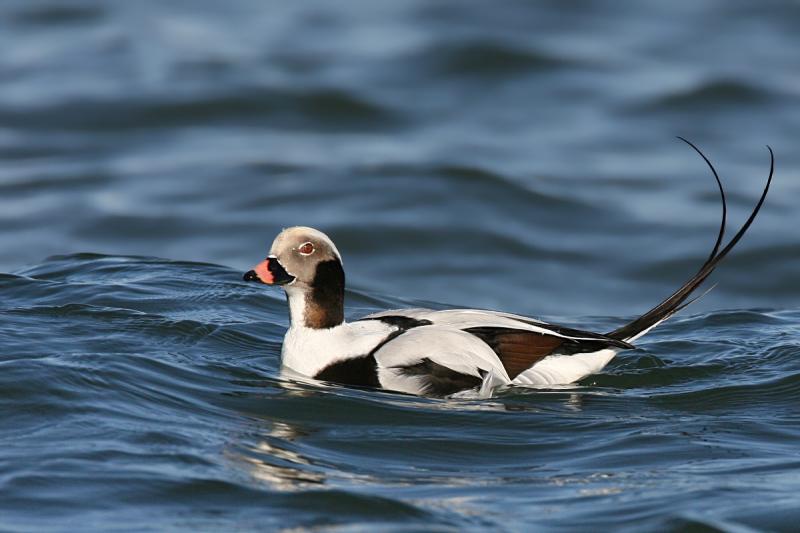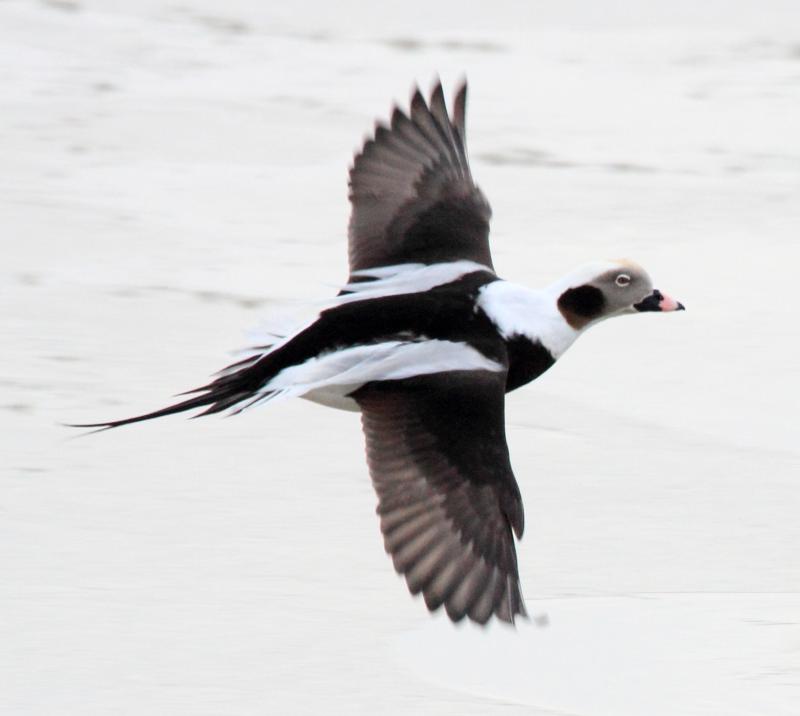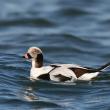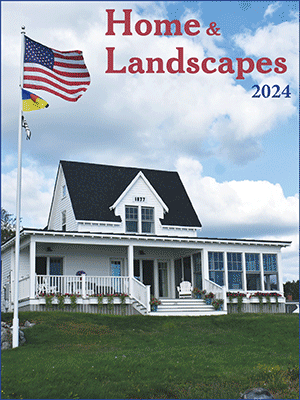Maine’s Arctic Canada Connection
 Some long-tailed ducks migrate from the Maine coast to the Nunavut Territory thousands of miles to the North in order to nest. The official adoption of the Nunavut Land Use Plan will be crucial to ensuring their breeding grounds remain intact and healthy. Photo by Wolfgang Wander, courtesy of Wikimedia Commons
Some long-tailed ducks migrate from the Maine coast to the Nunavut Territory thousands of miles to the North in order to nest. The official adoption of the Nunavut Land Use Plan will be crucial to ensuring their breeding grounds remain intact and healthy. Photo by Wolfgang Wander, courtesy of Wikimedia Commons
 The long tail trails behind on this male long-tailed duck, a feature presumably important in the selection of a mate by the females. Photo by Dominic Sherony, courtesy of Wikimedia Commons
The long tail trails behind on this male long-tailed duck, a feature presumably important in the selection of a mate by the females. Photo by Dominic Sherony, courtesy of Wikimedia Commons
 Some long-tailed ducks migrate from the Maine coast to the Nunavut Territory thousands of miles to the North in order to nest. The official adoption of the Nunavut Land Use Plan will be crucial to ensuring their breeding grounds remain intact and healthy. Photo by Wolfgang Wander, courtesy of Wikimedia Commons
Some long-tailed ducks migrate from the Maine coast to the Nunavut Territory thousands of miles to the North in order to nest. The official adoption of the Nunavut Land Use Plan will be crucial to ensuring their breeding grounds remain intact and healthy. Photo by Wolfgang Wander, courtesy of Wikimedia Commons
 The long tail trails behind on this male long-tailed duck, a feature presumably important in the selection of a mate by the females. Photo by Dominic Sherony, courtesy of Wikimedia Commons
The long tail trails behind on this male long-tailed duck, a feature presumably important in the selection of a mate by the females. Photo by Dominic Sherony, courtesy of Wikimedia Commons
Late in the day on Saturday, we took a ride down to look for birds at some favorite spots along the coast in Freeport. Parking by the narrow bridge at Wolfe’s Neck Farm, we scanned the bay, its dark rocky shores framed by tall, green pines contrasting with the blue sky. We expected perhaps to see a handful of bufflehead on the calm, flat waters, maybe a goldeneye or two. But looking south toward the shore of popular Wolfe’s Neck State Park, we were instead greeted with the sight of hundreds of American black ducks nestled into the narrow band of buffy saltmarsh grass. Interspersed among them were the expected mallards but also spiffy-looking northern pintails and tiny green-winged teal. Bufflehead were there, too—not just a handful but 50 or more, along with goldeneye, white-winged scoters, red-breasted mergansers, eiders, and loons!
We stayed there longer than we meant to, so when we got down to the South Freeport Boat Landing, a 15 minute car ride away, the light was fading. A quick scan from the wharf with our binoculars showed a distant flock of small ducks out on the water—more green-winged teal, we wondered? We set up the telescope to get a closer look. No, they weren’t teal but long-tailed ducks—the males with their extravagantly long tails trailing behind them. They floated close together, at least 80 of them, some sleeping, others giving their distinctive yodeling calls.
Long-tailed ducks are common along the Maine coast all winter but, more often than not, you are lucky to see more than 10 or 15 together in a flock. We guessed that this many birds together meant that they were likely beginning their migratory trek northward, perhaps even getting ready to take off for a nighttime flight to Canada.
The first leg of their journey might take them to the Maritimes or the St. Lawrence River of Quebec. But that’s barely a start for where they were likely headed because long-tailed ducks are largely Arctic breeders. In fact, most of their North American breeding range is within the northernmost part of Canada—the territory of Nunavut. That’s a long way to travel from the Maine coast. The closest mainland part of Nunavut is 1,500 miles away. Long-tailed ducks have been spotted in summer at the north end of Ellesmere Island in Nunavut. That’s 2,700 miles from the Maine coast!
Unfortunately, long-tailed ducks in Europe and North America have been declining and are now officially listed as Vulnerable on the IUCN Redlist. Ensuring that their breeding grounds remain a safe haven for them will be crucial to maintaining populations that are resilient to the factors impacting their long-term survival.
That’s why people who care about birds and the environment, even people like us living far to the south of the people of Nunavut, should be supportive of the plans that the people of Nunavut have been developing to take care of their lands and waters. For 15 years, they have been working to gather the knowledge of the people who have lived off those lands for millenia, supplementing it with western science and mapping the places that are critical for the survival of birds and other Arctic wildlife. All that knowledge has been woven together into something called the Nunavut Land Use Plan. When finally officially adopted, it will be one of the most well-balanced and well-thought-out plans to ensure healthy populations of the birds and other wildlife of one of the most important Arctic regions on the planet.
Those long-tailed ducks we watched on the coast of Maine in April may well be nesting in the spectacular 24-hour Arctic summer in Nunavut in a few months. How few of us would have known that the official adoption of the Nunavut Land Use Plan could be so important to the birds that spend half the year with us?
Jeffrey V. Wells, Ph.D., is a Fellow of the Cornell Lab of Ornithology and Vice President of Boreal Conservation for National Audubon. Dr. Wells is one of the nation's leading bird experts and conservation biologists. He is a coauthor of the seminal “Birds of Maine” book and author of the “Birder’s Conservation Handbook.” His grandfather, the late John Chase, was a columnist for the Boothbay Register for many years. Allison Childs Wells, formerly of the Cornell Lab of Ornithology, is a senior director at the Natural Resources Council of Maine, a nonprofit membership organization working statewide to protect the nature of Maine. Both are widely published natural history writers and are the authors of the popular books, “Maine’s Favorite Birds” (Tilbury House) and “Birds of Aruba, Bonaire, and Curaçao: A Site and Field Guide,” (Cornell University Press).





































